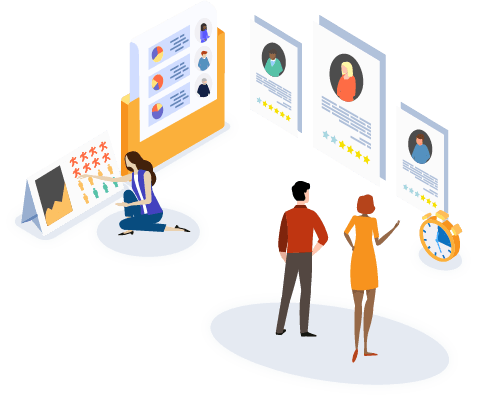What is HR analytics?
HR analytics is the process of collecting and analyzing Human Resource (HR) data in order to improve an organization’s workforce performance. The process can also be referred to as talent analytics, people analytics, or even workforce analytics HR metrics are the measurements that are used to quantify the costs and impacts of HR and business processes. Some examples of HR metrics are time to hire, training expense per employee, and work efficiency. HR analytics uses HR metrics to help leaders better understand how to move forward with business decisions.
What are the benefits of HR analytics?
HR analytics has many benefits for organizations that want to improve their workforce performance and processes. Some of the benefits are:
Improved hiring decisions: HR analytics helps HR professionals make better choices based on historical data. Through HR analytics, the recruiter and hiring team can make data-driven hiring decisions rather than “trusting their intuition” or “gut” and hoping for the best.
Managing employee performance and productivity: HR analytics can help measure and monitor the performance and productivity of employees and teams. By tracking metrics such as work efficiency, quality of work, goal achievement, and customer satisfaction, HR analytics can help identify strengths and weaknesses, provide feedback, and implement interventions to improve performance and productivity.
Preventing turnover: HR analytics can help reduce employee turnover by analyzing the reasons why employees leave and identifying the factors that influence retention. By using metrics such as turnover rate, retention rate, employee satisfaction, engagement, and loyalty, HR analytics can help predict which employees are at risk of leaving and design strategies to retain them.
Saving money: HR analytics can help save money by optimizing HR processes and reducing costs. For example, HR analytics can help reduce hiring costs by improving the quality of hire, reducing time to hire, and increasing hiring efficiency. HR analytics can also help reduce training costs by evaluating the effectiveness of learning and development programs and identifying the best methods and content for upskilling and reskilling employees.
Adding value to the business: HR analytics can help add value to the business by aligning HR goals with organizational goals and demonstrating the impact of HR initiatives on business outcomes. By using metrics such as revenue per employee, profit per employee, return on investment (ROI), and return on human capital (ROHC), HR analytics can help measure how HR contributes to the bottom line and supports the strategic vision of the organization.
What are the challenges of HR analytics?
HR analytics also has some challenges that organizations need to overcome to implement and use it effectively. Some of the challenges are:
Data quality, security, and privacy: HR analytics requires reliable and valid data sources, as well as ethical and legal frameworks to protect the data and the rights of employees. Data quality issues can affect the accuracy and validity of the analysis and insights. Data security and privacy issues can expose the organization to legal risks and reputational damage.
Mindset and culture: HR analytics requires a shift in mindset and culture from intuition-based decision making to evidence-based decision making. Many business leaders and HR professionals may not be ready or willing to embrace this change and may resist or distrust the data and analysis. HR analytics also requires a culture of transparency, collaboration, and accountability among stakeholders
Skill gap: HR analytics requires a specific set of skills and competencies that many HR professionals may not have. These include data literacy, analytical thinking, statistical methods, data visualization, storytelling, and business acumen. HR professionals need to develop these skills or partner with data experts to leverage HR analytics effectively.
ROI measurement: HR analytics requires a clear way of measuring the return on investment (ROI) of the HR initiatives and interventions that are based on the data and analysis. This can be challenging because many HR outcomes are intangible, long-term, or influenced by multiple factors. HR professionals need to establish clear metrics and indicators to track and evaluate the impact of HR analytics on the business.
Next Innovation Asia

